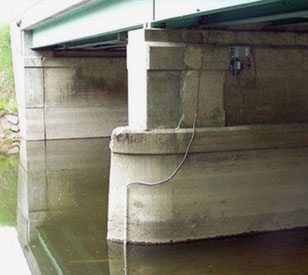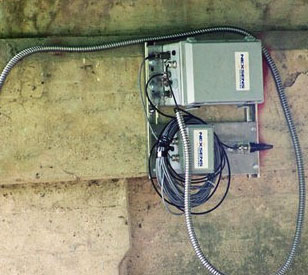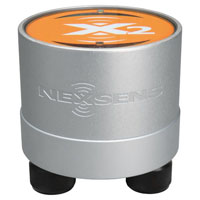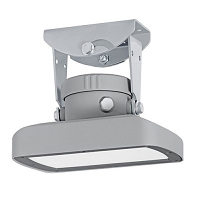 Proper bridge design depends on many factors, including accurate estimates of expected scour around bridge piers and abutments. As water passes through a constricted bridge opening, local accelerations cause scour, and the design of the bridge must account for it. Scour prediction models, however, contain a large amount of uncertainty due to the complexity of the physical processes at work. This is generally accounted for by overestimating expected scour depth to ensure the safety of the bridge. While overestimating scour depth is necessary for safety, it increases the cost of bridge construction.
Proper bridge design depends on many factors, including accurate estimates of expected scour around bridge piers and abutments. As water passes through a constricted bridge opening, local accelerations cause scour, and the design of the bridge must account for it. Scour prediction models, however, contain a large amount of uncertainty due to the complexity of the physical processes at work. This is generally accounted for by overestimating expected scour depth to ensure the safety of the bridge. While overestimating scour depth is necessary for safety, it increases the cost of bridge construction.
In an effort to reduce uncertainty associated with scour prediction models, the Michigan Department of Transportation awarded a research grant to Wayne State University and Lawrence Technological University to collect field-scale data related to pier scour. The study aims to reduce the cost of bridge construction without sacrificing safety.
Reducing uncertainty with monitoring
 The research team chose their initial site along the Flint River in Michigan. Soil and bridge characteristics, as well as the presence of a USGS real-time flow gauge, influenced site selection. A Tritech Micron Echo Sounder measures the depth to the riverbed, and a NexSens AccuStage vented pressure transducer measures the changes in water level.
The research team chose their initial site along the Flint River in Michigan. Soil and bridge characteristics, as well as the presence of a USGS real-time flow gauge, influenced site selection. A Tritech Micron Echo Sounder measures the depth to the riverbed, and a NexSens AccuStage vented pressure transducer measures the changes in water level.
Both instruments were placed inside a PVC tube with a 90-degree bend; the PVC housing was installed on the bridge pier, with the elbow resting on top of the spread footing to prevent vertical movement. The AccuStage pressure transducer was installed to the depth of the footing, while the Micron Echo Sounder was cantilevered over the footing. Cabling for both instruments runs through the top of the PVC housing and into a NexSens iSIC data logger with cellular telemetry.
The Micron Echo Sounder requires more power than the standard 8.5 amp-hour iSIC battery can supply. To compensate, an external 55 amp-hour marine battery, mounted on top of the pier, powers the system. A uni-strut frame anchors the iSIC data logger to the top of the bridge pier, and a NexSens A23 30-watt solar panel provides a continuous charge to the marine battery, eliminating the need to swap batteries.
Bridge scour data is collected once per hour and transmitted via cellular telemetry to a project computer running iChart Software. The results are saved on a network storage device shared between the universities and project sponsor.
The NexSens X2 Environmental Data Logger offers the latest in real-time monitoring technology with wireless communication, large plug-and-play sensor library, and ultra-low power consumption.
The OTT RLS, non-contact radar level sensor with pulse radar technology is ideal for monitoring in remote or hard to reach locations.
WQData LIVE is a web-based project management service that allows users 24/7 instant access to data collected from remote telemetry systems.



